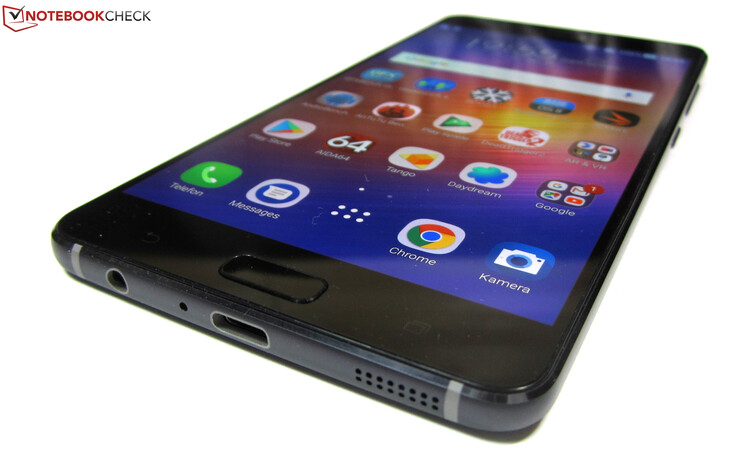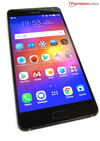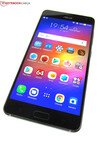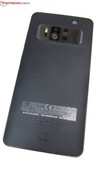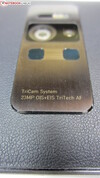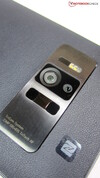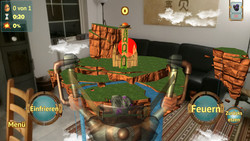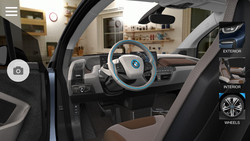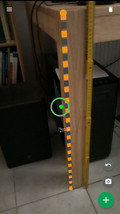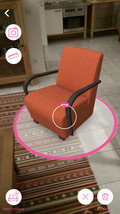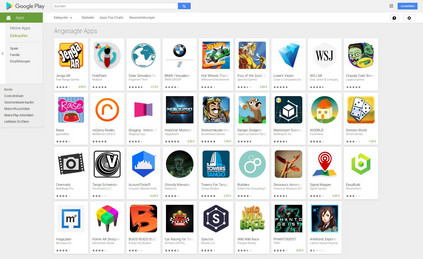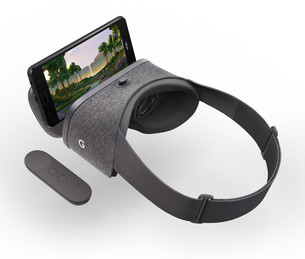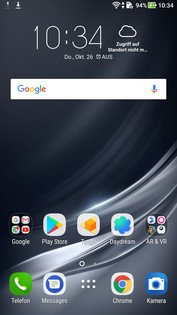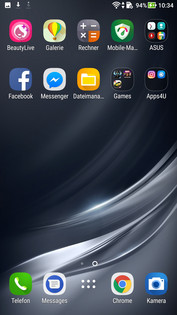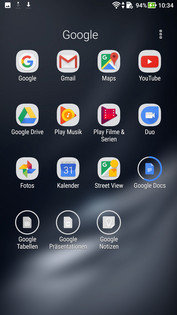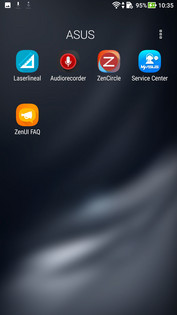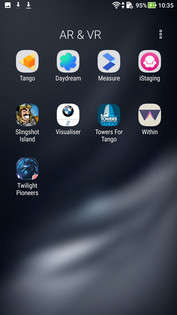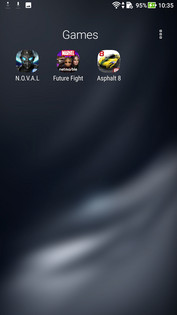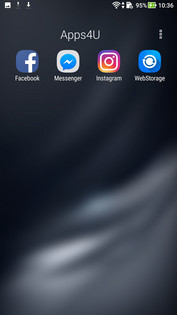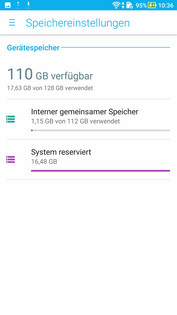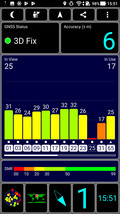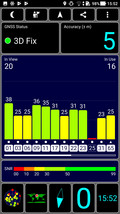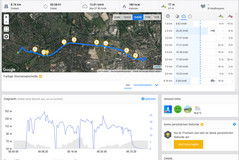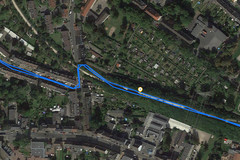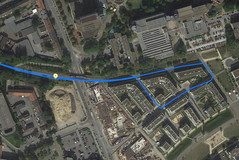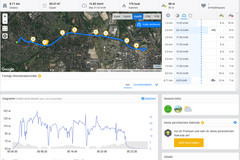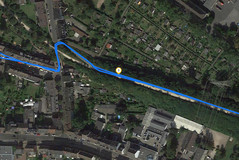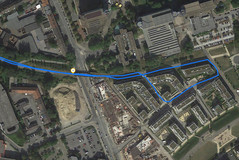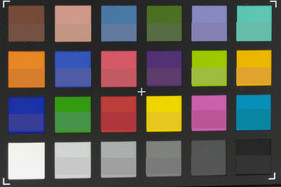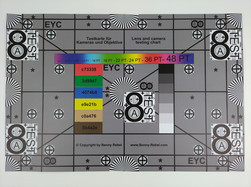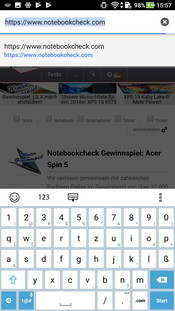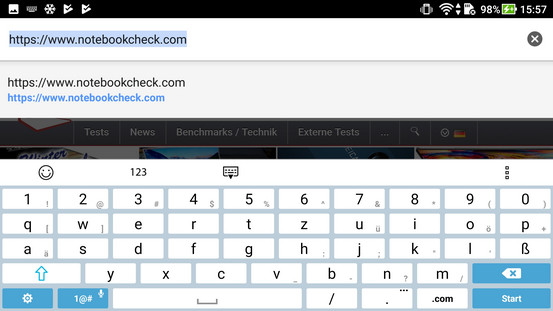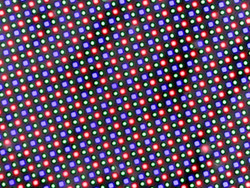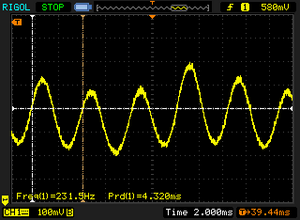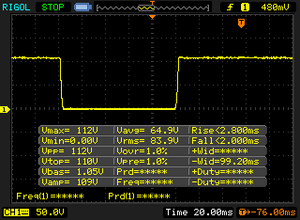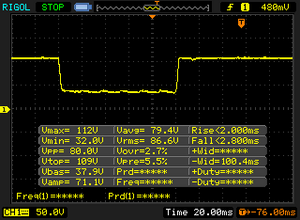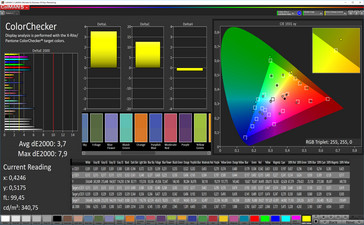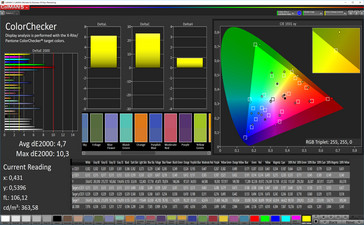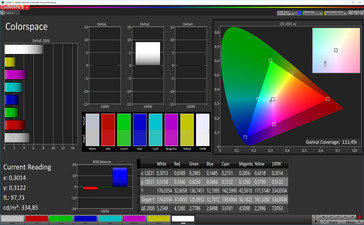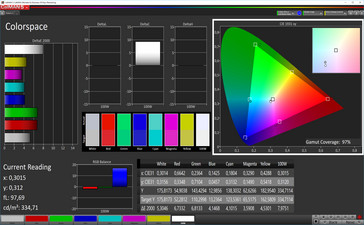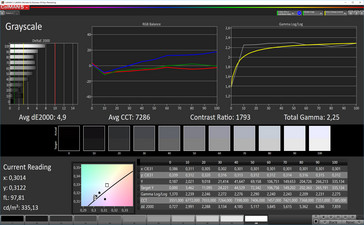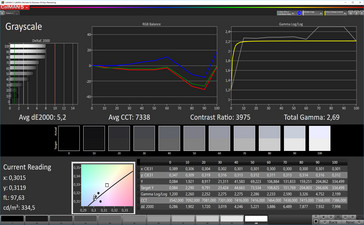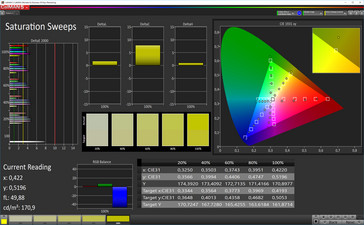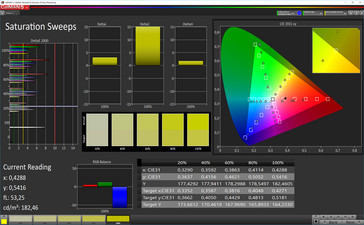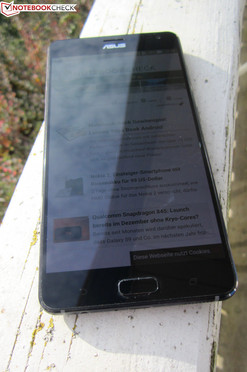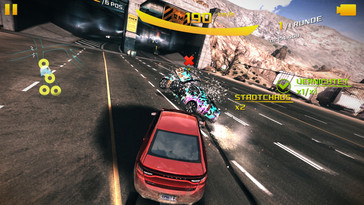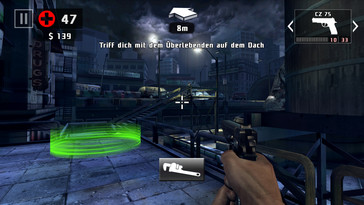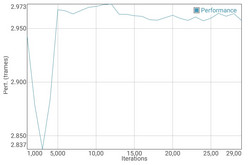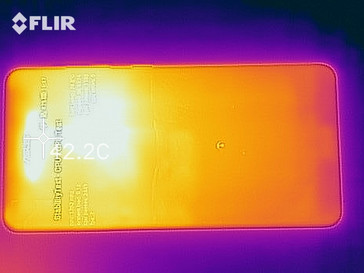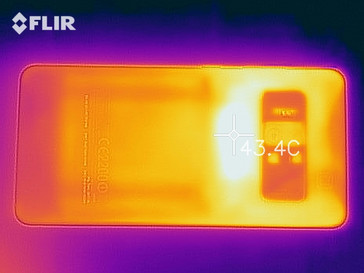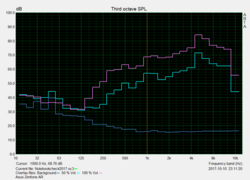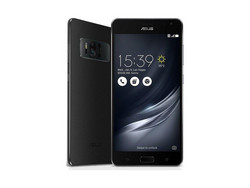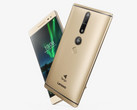Asus ZenFone AR (ZS571KL) Smartphone Review

For the original German review, see here.
Asus’s ZenFone AR is noteworthy for two separate and completely independent reasons. First of all, the Qualcomm Snapdragon 821 MSM8996 Pro powered 5.7-inch (WQHD OLED) Android 7.0 smartphone is the first smartphone ever to be equipped with up to 8 GB of RAM. Its second distinctive feature is much more interesting though.
According to Asus, the ZenFone AR is the first smartphone ever to be certified for Google Tango as well as Google Daydream. Thus, it is not only capable of adding virtual objects in real time to its recorded image stream (augmented reality) but also produce a virtual reality output thereof via the optional Daydream 3D virtual reality glasses. This feature set comes at a high price, though: our review unit, equipped with 6 GB of RAM and 128 GB of internal storage currently sells for around $770.
We have already witnessed an Android phone’s first steps into the AR world with the Lenovo Phab 2 Pro. Unfortunately, due to its weak and slow hardware it was unable to cope with the high demands of augmented reality; a problem we do not expect to see with the ZenFone AR thanks to its much more powerful SoC. Our review is going to reveal how well that turned out. In addition to the Lenovo Phab 2 Pro, we are also going to compare the ZenFone to similarly equipped high-end smartphones, such as the Apple iPhone 8, the LG G6, the OnePlus 5, and the Samsung Galaxy S8.
Case
The ZenFone’s aluminum case is covered by Corning Gorilla Glass 4 at the front and roughened leather at the back. While the leather does provide extra grip, it feels more like cheap plastic instead. The custom-made camera module named TriCam developed and designed specifically for Tango AR and Daydream VR is located at the rear as well. It is comprised of a 23 MP main camera as well as two additional cameras for motion detection and depth of field calculation. It protrudes slightly from the case resulting in a minor yet noticeable wobble when placed face up on a table.
At 8.95 mm the ZenFone AR is thicker than almost all of its competitors. Only the 10.7 mm (~0.42 in) thick 6.4-inch Lenovo Phab 2 is even bulkier. Nevertheless, the phone feels very slender and leaves a very decent high-quality impression thanks to its narrow consistent gaps and sturdy chassis. The 5.7-inch case does neither bend easily, nor does it flex at any given point.
Connectivity
According to Asus the ZenFone AR is equipped with Qualcomm's Snapdragon 821 MSM8996 Pro SoC that has been optimized for Google’s augmented reality technology Tango. It comes with an Adreno 530 GPU and an LPDDR4 memory controller with access to at least 6 GB of RAM. Regular apps do not really benefit from that much RAM just yet. Tango apps, on the other hand, should benefit immensely, for which the Lenovo Phab 2 Pro (Snapdragon 652 MSM8976, 4 GB of RAM) is living proof: it supports Tango as well, but in our review turned out to be overwhelmed by augmented reality applications.
Officially, the ZenFone AR is also going to be available with 8 GB of RAM. However, Asus has yet to clarify in which countries and regions this model is going to be available and when. As of November 2017, only the 6 GB model is available in Europe and the US.
It is equipped with fast UFS 2.0 memory ranging from 64 GB all the way to 256 GB. Our review unit was equipped with 128 GB of storage, of which 110 GB were user accessible out of the box.
Theoretically, storage expansion via a microSD card with up to 2 TB is supported as well. However, to date, no microSD cards larger than 400 GB are available. With the microSD card inserted into the Nano SIM / Micro SD tray the devices loses its Dual SIM capabilities. Installing apps on the microSD card was not possible on the ZenFone AR since it formatted the SD card as removable storage that can only be used for storing media files.
The USB Type-C port supports USB 2.0 as well as USB-OTB and Quick Charge 3.0. A high-resolution sound chip (up to 24 Bit/192 kHz) is also built-in.
Software
Google’s Android 7.0 operating system has been modified by Asus to some degree. For example, the ZenFone AR comes with Asus’s own user interface ZenUI 3.0. At the time of review (October 2017) the latest security patch level available was August 2017. Thus, the phone was already out-of-date.
The phone’s focus is clearly on Tango. Google’s Tango app can be found right there on the home screen and serves as both, AR app store and AR app launcher. Some AR apps are already preloaded on the phone.
But what exactly are Tango apps? Basically, a Tango app is an Android application presenting one or several overlays to the camera viewfinder’s live image. Most of them are mere gimmicks at this point. Let us take “Slingshot Island” for example: it transforms your smartphone into a slingshot that allows you to sling rocks at virtual castles in your surroundings. Some educational value can be found in Solar Simulator, an app that presents you with a to-scale solar system model and allows you to travel back and forth between the planets. The measure app, on the other hand, is a virtual tape measure: you set a starting and an end point and get the distance between the two shown on your screen.
And while most Tango apps are gimmicks at this point, some of them are excellent showcases for the high potential of AR applications in the near future. For example, BMW’s i Visualizer allows you to take a virtual seat inside a BMW i3, i3s, or i8 and fiddle around with its controls (e.g. turn on the lights or open the doors). And it gets even more interesting when combined with Google’s Daydream View Headset 3D glasses: that way you can inspect the BMW models very closely and realistically prior to purchasing one. Thanks to the phones high-resolution WQHD display virtual quality and the subsequent 3D effect are top notch.
Dressing and virtual furniture apps, such as Dressing Room, Lowe’s, Wayfair, or iStaging offer a similar experience. Dressing Room, for example, allows you to dress up a mannequin modelled after your exact measurements to your liking and purchase the clothes right away. Lowe’s, Wayfair, and iStaging allow you to place virtual furniture and decorative items in your rooms to see how well (or bad) they would actually look in that particular space. Unfortunately, these apps lack a zoom feature and virtually furnishing a small room can become quite finicky.
All this is possible thanks to the ZenFone AR’s dual camera system. The cameras memorize the three-dimensional coordinates of objects very accurately and allow the user to literally walk around the virtual items in order to look at them from all sides. Occasional hiccups include a slight shift in proportions between the real environment and the virtual object in question, and those can most often be solved by simply moving the smartphone slightly thereby changing the viewing angle between the camera and the virtual object.
Measuring distances worked surprisingly well if the two end points were within 2 m (approx. 7 ft) of the user and assuming the aiming was performed accurately. But even then the measuring app did sometimes focus on the wrong spot rendering the measurement obsolete. In addition, the app had trouble with objects that were farther away (more than 10 m/33 ft).
Overall, the AR experience with the ZenFone AR was much better than the AR experience with the Lenovo Phab 2 Pro. Not once did we experience slowdowns or graphical glitches in Tango apps, and while the ZenFone AR did get noticeably warm up, it never reached the point where it got uncomfortable to hold. However, surface temperatures become less of an issue anyway once the phone is installed in virtual reality glasses.
There is only one real downside: the number of Tango apps is still fairly low, and no more than 30 apps and games are available at this point. Google keeps an up-to-date list of Tango apps here.
The rest of the preloaded apps are either Google apps or Asus’s own apps, such as ZenCircle or ZenTalk, and a small selection of games and apps that luckily can all be uninstalled.
Communication and GPS
Thanks to LTE Cat. 11, the ZenFone AR supports downstream and upstream transfer speeds of up to 600 MBit/s and 75 MBit/s, respectively. During our review period, Vodafone mobile reception was flawless, even in rural areas. Thanks to support for a total of 23 network bands, the phone should be able to get a signal pretty much anywhere on this planet. However, those of us who require even more connectivity worldwide are better off with the Apple iPhone 8 or the OnePlus 5. The latter supports up to 34 network bands.
In terms of Wi-Fi, the ZenFone AR supports 802.11a/b/g/n/ac and is thus capable of utilizing the lesser used 5 GHz band as well. In our test connected to our Linksys EA8500 reference router, it reached a very good 340 MBit/s (RX), and was thus about as fast as the Lenovo Phab 2 Pro and the LG G6. Due to a lack of MIMO antennas, it could not keep up with the likes of Samsung's Galaxy S8, the OnePlus 5, or Apple’s iPhone 8.
| Networking | |
| iperf3 transmit AX12 | |
| Samsung Galaxy S8 | |
| OnePlus 5 | |
| Apple iPhone 8 | |
| Asus ZenFone AR ZS571KL | |
| Lenovo Phab 2 Pro | |
| LG G6 | |
| iperf3 receive AX12 | |
| Apple iPhone 8 | |
| OnePlus 5 | |
| Asus ZenFone AR ZS571KL | |
| Samsung Galaxy S8 | |
| LG G6 | |
| Lenovo Phab 2 Pro | |
Location services support positioning via GPS, GLONASS, and BeiDou, and position lock was obtained fairly quickly, even indoors with an accuracy of 6 m (~20 ft; 5 m/~16 ft accuracy outdoors).
We examine a smartphone’s GPS accuracy on an 8.8 km (~5.5 mi) long bike ride, where we compare it to a professional Garmin Edge 500 GPS. The ZenFone AR did very well in this test. At the end of the ride, the difference between the two was just 50 m (~55 yd), and occasionally, the ZenFone AR was more accurate than the Garmin Edge 500. Thus, the ZenFone AR is quite suitable for everyday navigation purposes.
Telephony and Call Quality
Call Quality was more than decent when used conventionally or on speakerphone regardless of the opposite side’s connection (landline / mobile). Flat down on the table the ZenFone AR was quite usable on speakerphone thanks to the position of the speaker on the side.
In case two SIM cards are installed, one of the two can be selected as the primary SIM card for voice calls, text messages, and data. Both SIM slots offer support for 2G/3G/4G, although only one SIM card can be connected to an LTE network at a time.
Cameras
The ZenFone AR’s main camera features a 4K capable 23 MP sensor with f/2.0 aperture, 4-way optical image stabilization (OIS), three-way electronic image stabilization (EIS), a dual LED flash and a 77 ° field of view. The sensor behind all this is Sony’s 1/2.6-inch Exmor RS IMX318.
Asus refers to the main rear camera as TriCam due to the fact that two extra cameras are installed in addition to the main camera. The first is used for motion detection, the second for measuring the distance to and between objects and general depth of field visualization. All three cameras are required for Google’s Tango. The main 23 MP camera is accompanied by an 8 MP shooter at the front.
In bright daylight, the main camera’s image quality is very decent (see scenes 1 and 2), with vibrant colors and a high dynamic range. However, Unlike its competitors, some photos taken with the ZenFone AR tend to lack sharpness and fine details. Low-light quality is only so-so. Our sample photo (scene 3) seems blurry at first sight already, and upon closer inspection it lacks details quite visibly. Video recording quality (max. 4K/3840x2160 @ 30 FPS) is very decent.
The extensive camera app is noteworthy. It allows access to all relevant settings, including manual shutter mode, bokeh, and face detection. The app also supports raw photography (extension: DNG) and its image improvement algorithms work their wonders on the front-facing 8 MP camera as well. Unfortunately, the front-facing camera supports only 1280x720 @ 20 FPS video recording.
We also test every camera under controlled lighting conditions using the X-Rite ColorChecker Passport to determine color accuracy and a standardized test chart to determine focus and image sharpness.
Colors are slightly oversaturated, but only barely so. Generally speaking colors are on the bright side, which ensures very vivid high-contrast photos. Image sharpness is not the best, and our test chart turned out to be something of a challenge for the ZenFone AR. Even at the very center, the point where most cameras have no problems whatsoever, the photos lacked sharpness. This became particularly obvious when inspecting the transitions between the edges. On the other hand, the overall focus remained mostly unchanged for the entire image, and the color gradient was very accurate.
Accessories and Warranty
The ZenFone AR comes with a modular charger, a USB Type-C cable, a USB Type-C to Type-A adapter, a SIM tool, headphones, a quick start guide, and a warranty booklet.
In addition, our review unit also came with the optional Google Daydream View headset for a three-dimensional virtual reality experience. The glasses are not sold by Asus directly, but can be obtained through various retail channels for around $75.
While European models are sold with a limited 24-month warranty, US models include a limited 12-month warranty. Please see our Guarantees, Return Policies & Warranties FAQ for country-specific information.
Input Devices and Handling
The 10-point multitouch touchscreen feels pleasantly silky to the touch, and does not suffer from any noticeable input delay, either in the middle or on the sides and edges of the display. The usual Android buttons for back and tabs are illuminated soft-touch buttons while the physical home button houses the fingerprint reader. Like the volume rocker and the power button it feels very sturdy with firm feedback. The default keyboard is Asus’s ZenUI keyboard, but it can be easily replaced with other keyboards available through Google’s Play Store.
Display
ZenFone AR’s WQHD (2560x1440) Super AMOLED panel is protected by Gorilla Glass 4, and the phone’s screen to body ratio is 79%. Considering the comparatively small display size, the resulting pixel density is an impressive 515 PPI, and individual pixels are not distinguishable with the naked eye anymore. Due to its OLED nature, each pixel can be individually enabled or disabled, meaning that the display does not require a uniform backlight anymore. Accordingly, blacks are really black.
The display’s maximum brightness of 341 nits is not bad, but it is also nothing to write home about considering that it got bested by every single one of its competitors by a significant margin. The real-world APL50 test with evenly distributed bright and dark areas results in a maximum brightness of 402 nits, and the ZenFone AR’s brightness distribution is very decent at 90%.
Unfortunately, the display flickers at a low 231.5 Hz, meaning that it is being turned off and on again 231.5 times per second. Sensitive users might notice this low-frequency flickering. On the other hand, the display comes with a blue light filter and a very low minimum brightness of 7.06 nits, both of which help to reduce eyestrain in the evenings and in low-light environments.
| |||||||||||||||||||||||||
Brightness Distribution: 90 %
Center on Battery: 338 cd/m²
Contrast: ∞:1 (Black: 0 cd/m²)
ΔE ColorChecker Calman: 3.7 | ∀{0.5-29.43 Ø4.78}
ΔE Greyscale Calman: 4.9 | ∀{0.09-98 Ø5}
Gamma: 2.25
CCT: 7286 K
| Asus ZenFone AR ZS571KL Super AMOLED, 2560x1440, 5.7" | Lenovo Phab 2 Pro IPS, 2560x1440, 6.4" | Apple iPhone 8 IPS True Tone, 1334x750, 4.7" | LG G6 IPS LCD, 2880x1440, 5.7" | Samsung Galaxy S8 Super AMOLED, 2960x1440, 5.8" | OnePlus 5 AMOLED, 1920x1080, 5.5" | |
|---|---|---|---|---|---|---|
| Screen | -18% | 59% | 20% | 39% | 38% | |
| Brightness middle (cd/m²) | 338 | 472.4 40% | 604 79% | 646 91% | 566 67% | 426 26% |
| Brightness (cd/m²) | 341 | 479 40% | 580 70% | 611 79% | 564 65% | 431 26% |
| Brightness Distribution (%) | 90 | 93 3% | 91 1% | 89 -1% | 94 4% | 93 3% |
| Black Level * (cd/m²) | 0.482 | 0.44 | 0.23 | |||
| Colorchecker dE 2000 * | 3.7 | 7 -89% | 1.2 68% | 4.5 -22% | 2.7 27% | 1.6 57% |
| Colorchecker dE 2000 max. * | 7.9 | 11 -39% | 2.3 71% | 8.3 -5% | 5.4 32% | 4.1 48% |
| Greyscale dE 2000 * | 4.9 | 7.9 -61% | 1.6 67% | 6 -22% | 3.1 37% | 1.7 65% |
| Gamma | 2.25 98% | 2.34 94% | 2.25 98% | 2.27 97% | 2.15 102% | 2.25 98% |
| CCT | 7286 89% | 7826 83% | 6688 97% | 7996 81% | 6335 103% | 6329 103% |
| Contrast (:1) | 980 | 1373 | 2809 | |||
| Color Space (Percent of AdobeRGB 1998) (%) | 67.74 | 81.57 | ||||
| Color Space (Percent of sRGB) (%) | 99.05 | 99.87 |
* ... smaller is better
Screen Flickering / PWM (Pulse-Width Modulation)
| Screen flickering / PWM detected | 231.5 Hz | ||
The display backlight flickers at 231.5 Hz (worst case, e.g., utilizing PWM) . The frequency of 231.5 Hz is relatively low, so sensitive users will likely notice flickering and experience eyestrain at the stated brightness setting and below. In comparison: 53 % of all tested devices do not use PWM to dim the display. If PWM was detected, an average of 8111 (minimum: 5 - maximum: 343500) Hz was measured. | |||
Display Response Times
| ↔ Response Time Black to White | ||
|---|---|---|
| 4.8 ms ... rise ↗ and fall ↘ combined | ↗ 2.8 ms rise | |
| ↘ 2 ms fall | ||
| The screen shows very fast response rates in our tests and should be very well suited for fast-paced gaming. In comparison, all tested devices range from 0.1 (minimum) to 240 (maximum) ms. » 16 % of all devices are better. This means that the measured response time is better than the average of all tested devices (20.2 ms). | ||
| ↔ Response Time 50% Grey to 80% Grey | ||
| 4.8 ms ... rise ↗ and fall ↘ combined | ↗ 2 ms rise | |
| ↘ 2.8 ms fall | ||
| The screen shows very fast response rates in our tests and should be very well suited for fast-paced gaming. In comparison, all tested devices range from 0.165 (minimum) to 636 (maximum) ms. » 15 % of all devices are better. This means that the measured response time is better than the average of all tested devices (31.6 ms). | ||
Thanks to the high-contrast display, colors are very vivid and fresh. Using the CalMAN software in combination with a spectrophotometer allows us to determine the panel’s color accuracy and coverage. In both color spaces color representation was fairly accurate, although DeltaE for grayscales was slightly above its ideal value of 3. We were also able to determine a slight blue tint in both color spaces, which turned out to be more pronounced in the sRGB space than in the AdobeRGB space. However, it was barely, if at all noticeable in everyday use.
While the display’s overall maximum brightness certainly was not the best, it was good enough to remain usable even in very bright ambient light. Direct sunlight, however, rendered the display useless and required us to either find a shady spot or to realign the phone accordingly. Overall, the ZenFone AR is definitely usable outdoors.
Viewing angles are very decent and the display does not dim even when viewed from acute angles. As is quite common for OLED displays, a slight green tint appears when viewed from an angle. However, it remained largely unobtrusive when viewed at normal, aka not too acute angles.
Performance
Qualcomm’s Snapdragon 821 MSM8996 Pro is a real powerhouse, and its Qualcomm Adreno 530 GPU is one of the fastest smartphone GPUs available today. Up to 8 GB of RAM and 256 GB of storage space are theoretically possible, but our review unit was equipped with 6 GB of RAM and 128 GB of internal storage space.
Despite its powerful hardware, the competition among high-end smartphones is fierce and the ZenFone AR was not the fastest kid on the block. It performed similarly to the LG G6 and faster than the Lenovo Phab 2 Pro, even though it did not stand a chance against the Samsung Galaxy S8, the OnePlus 5, and the Apple iPhone 8.
| AnTuTu v6 - Total Score (sort by value) | |
| Asus ZenFone AR ZS571KL | |
| Lenovo Phab 2 Pro | |
| Apple iPhone 8 | |
| LG G6 | |
| Samsung Galaxy S8 | |
| OnePlus 5 | |
| PCMark for Android | |
| Work performance score (sort by value) | |
| Asus ZenFone AR ZS571KL | |
| LG G6 | |
| Samsung Galaxy S8 | |
| OnePlus 5 | |
| Work 2.0 performance score (sort by value) | |
| Asus ZenFone AR ZS571KL | |
| LG G6 | |
| Samsung Galaxy S8 | |
| OnePlus 5 | |
| Geekbench 4.4 | |
| 64 Bit Single-Core Score (sort by value) | |
| Asus ZenFone AR ZS571KL | |
| Apple iPhone 8 | |
| LG G6 | |
| Samsung Galaxy S8 | |
| OnePlus 5 | |
| 64 Bit Multi-Core Score (sort by value) | |
| Asus ZenFone AR ZS571KL | |
| Apple iPhone 8 | |
| LG G6 | |
| Samsung Galaxy S8 | |
| OnePlus 5 | |
| Compute RenderScript Score (sort by value) | |
| LG G6 | |
| Samsung Galaxy S8 | |
| OnePlus 5 | |
| GFXBench (DX / GLBenchmark) 2.7 | |
| T-Rex Onscreen (sort by value) | |
| Asus ZenFone AR ZS571KL | |
| Lenovo Phab 2 Pro | |
| Apple iPhone 8 | |
| LG G6 | |
| Samsung Galaxy S8 | |
| OnePlus 5 | |
| 1920x1080 T-Rex Offscreen (sort by value) | |
| Asus ZenFone AR ZS571KL | |
| Lenovo Phab 2 Pro | |
| Apple iPhone 8 | |
| LG G6 | |
| Samsung Galaxy S8 | |
| OnePlus 5 | |
| GFXBench 3.0 | |
| on screen Manhattan Onscreen OGL (sort by value) | |
| Asus ZenFone AR ZS571KL | |
| Lenovo Phab 2 Pro | |
| Apple iPhone 8 | |
| LG G6 | |
| Samsung Galaxy S8 | |
| OnePlus 5 | |
| 1920x1080 1080p Manhattan Offscreen (sort by value) | |
| Asus ZenFone AR ZS571KL | |
| Lenovo Phab 2 Pro | |
| Apple iPhone 8 | |
| LG G6 | |
| Samsung Galaxy S8 | |
| OnePlus 5 | |
| GFXBench 3.1 | |
| on screen Manhattan ES 3.1 Onscreen (sort by value) | |
| Asus ZenFone AR ZS571KL | |
| Lenovo Phab 2 Pro | |
| Apple iPhone 8 | |
| LG G6 | |
| Samsung Galaxy S8 | |
| OnePlus 5 | |
| 1920x1080 Manhattan ES 3.1 Offscreen (sort by value) | |
| Asus ZenFone AR ZS571KL | |
| Lenovo Phab 2 Pro | |
| Apple iPhone 8 | |
| LG G6 | |
| Samsung Galaxy S8 | |
| OnePlus 5 | |
| GFXBench | |
| on screen Car Chase Onscreen (sort by value) | |
| Asus ZenFone AR ZS571KL | |
| Lenovo Phab 2 Pro | |
| LG G6 | |
| Samsung Galaxy S8 | |
| OnePlus 5 | |
| 1920x1080 Car Chase Offscreen (sort by value) | |
| Asus ZenFone AR ZS571KL | |
| Lenovo Phab 2 Pro | |
| LG G6 | |
| Samsung Galaxy S8 | |
| OnePlus 5 | |
The browser benchmark scores pretty much reflected this as well. The iPhone 8 dominated the field, and both the ZenFone AR and the LG G6 fell behind the Samsung Galaxy S8 and the OnePlus 5. Subjectively speaking, we had no complaints. Websites loaded very quickly and we did not notice any stuttering whatsoever. Even demanding HTML5 games such as http://letsplay.ouigo.com/ were buttery smooth.
| JetStream 1.1 - Total Score | |
| Apple iPhone 8 | |
| OnePlus 5 (Chrome 59) | |
| Samsung Galaxy S8 (Samsung Browser 5.2) | |
| Asus ZenFone AR ZS571KL (Chrome 58.0.3029.83) | |
| LG G6 (Chrome 57) | |
| Lenovo Phab 2 Pro (Chrome 54.0.2840.85) | |
| Octane V2 - Total Score | |
| Apple iPhone 8 | |
| Samsung Galaxy S8 (Samsung Browser 5.2) | |
| OnePlus 5 (Chrome 59) | |
| Asus ZenFone AR ZS571KL (Chrome 58.0.3029.83) | |
| LG G6 (Chrome 57) | |
| Lenovo Phab 2 Pro (Chrome 54.0.2840.85) | |
| Mozilla Kraken 1.1 - Total | |
| Lenovo Phab 2 Pro (Chrome 54.0.2840.85) | |
| OnePlus 5 (Chrome 59) | |
| LG G6 (Chrome 57) | |
| Asus ZenFone AR ZS571KL (Chrome 58.0.3029.83) | |
| Samsung Galaxy S8 (Samsung Browser 5.2) | |
| Apple iPhone 8 | |
| WebXPRT 2015 - Overall | |
| Apple iPhone 8 | |
| Samsung Galaxy S8 (Samsung Browser 5.2) | |
| OnePlus 5 (Chrome 59) | |
| Asus ZenFone AR ZS571KL (Chrome 58.0.3029.83) | |
| LG G6 (Chrome 57) | |
| Lenovo Phab 2 Pro | |
* ... smaller is better
The storage performance is fairly decent thanks to its UFS 2.0 storage. However, both the Samsung Galaxy S8 and OnePlus 5 are equipped with UFS 2.1 and were both quite a bit faster.
However, the tables were turned when it came to microSD performance. Not one of its competitors managed to come even close to the AR’s 83.4 MB/s when benchmarked with our Toshiba Exceria Pro M501 reference card (up to 270 MB/s read, up to 150 MB/s write).
| Asus ZenFone AR ZS571KL | Lenovo Phab 2 Pro | LG G6 | Samsung Galaxy S8 | OnePlus 5 | |
|---|---|---|---|---|---|
| AndroBench 3-5 | -22% | -2% | 21% | 52% | |
| Sequential Read 256KB (MB/s) | 458.9 | 255 -44% | 428.7 -7% | 793 73% | 748 63% |
| Sequential Write 256KB (MB/s) | 142.8 | 138 -3% | 122.8 -14% | 193.2 35% | 201.5 41% |
| Random Read 4KB (MB/s) | 88.4 | 38.53 -56% | 95.2 8% | 127.2 44% | 141 60% |
| Random Write 4KB (MB/s) | 13.51 | 12.92 -4% | 16.58 23% | 15.25 13% | 19.3 43% |
| Sequential Read 256KB SDCard (MB/s) | 83.4 ? | 71.9 ? -14% | 77.6 ? -7% | 63.9 ? -23% | |
| Sequential Write 256KB SDCard (MB/s) | 62.6 ? | 54.8 ? -12% | 53.3 ? -15% | 53.5 ? -15% |
Gaming
Qualcomm’s Adreno 530 GPU is one of the fastest smartphone GPUs available today. Accordingly, the ZenFone AR had absolutely no trouble running all current Android games smoothly and without stuttering, including the very demanding test games “Asphalt 8: Airborne” and “Dead Trigger 2”. Sensors and touchscreen turned out to work very accurately, and the only killjoy was the ZenFone AR’s poorly located mono speaker. In landscape mode, the sound did not seem to be originating from the center, but rather the left or right side of the phone, depending on orientation. We also managed to cover it accidentally quite frequently.
| Dead Trigger 2 | |||
| Settings | Value | ||
| high | 56 fps | ||
| Asphalt 8: Airborne | |||
| Settings | Value | ||
| high | 30 fps | ||
| very low | 30 fps | ||
Emissions
Temperature
Even under full load the phone never got uncomfortably warm. After around one hour of maximum load the hottest spot we found was measured at just 37.9 °C (~100 °F), and the average temperature at the front was 34.9 °C (~95 °F). When idle, it reached no more than 25.3 °C (~78 °F) on average.
We found no evidence of throttling, even under full load. In GFXBench’s Manhattan ES 3.1 scenario, the frame rate remained consistently high even after 30 reruns.
(+) The maximum temperature on the upper side is 37.8 °C / 100 F, compared to the average of 35.2 °C / 95 F, ranging from 21.9 to 247 °C for the class Smartphone.
(+) The bottom heats up to a maximum of 37.9 °C / 100 F, compared to the average of 34 °C / 93 F
(+) In idle usage, the average temperature for the upper side is 25.8 °C / 78 F, compared to the device average of 32.9 °C / 91 F.
Speakers
With a maximum sound level of 88.4 dB(A), the ZenFone AR’s mono speaker located at the bottom of the phone can become fairly loud. Mids and Highs are nicely balanced, but as usual the smartphone lacks bass. Accordingly, the soundscape is rather tinny and thin, but certainly sufficient for the occasional YouTube or Spotify experience. The integrated sound chip is capable of high-resolution audio output at 24 Bit/96 kHz or 24 Bit/192 kHz.
Not only does the included headset improve the sound quality immensely, it also supports DTS Headphones:X 7.1 Virtual Surround sound. Unfortunately, the source material has to be encoded appropriately to benefit from this. 7.1 sound samples, for example in movie trailers, can be found here.
Asus ZenFone AR ZS571KL audio analysis
(+) | speakers can play relatively loud (88.4 dB)
Bass 100 - 315 Hz
(-) | nearly no bass - on average 24.7% lower than median
(±) | linearity of bass is average (9.8% delta to prev. frequency)
Mids 400 - 2000 Hz
(+) | balanced mids - only 3.6% away from median
(+) | mids are linear (4.2% delta to prev. frequency)
Highs 2 - 16 kHz
(±) | higher highs - on average 8.6% higher than median
(+) | highs are linear (6.8% delta to prev. frequency)
Overall 100 - 16.000 Hz
(±) | linearity of overall sound is average (21.6% difference to median)
Compared to same class
» 43% of all tested devices in this class were better, 8% similar, 50% worse
» The best had a delta of 11%, average was 35%, worst was 134%
Compared to all devices tested
» 60% of all tested devices were better, 7% similar, 33% worse
» The best had a delta of 4%, average was 24%, worst was 134%
Lenovo Phab 2 Pro audio analysis
(+) | speakers can play relatively loud (84.5 dB)
Bass 100 - 315 Hz
(-) | nearly no bass - on average 22.8% lower than median
(±) | linearity of bass is average (11.4% delta to prev. frequency)
Mids 400 - 2000 Hz
(+) | balanced mids - only 2.2% away from median
(+) | mids are linear (4.7% delta to prev. frequency)
Highs 2 - 16 kHz
(±) | higher highs - on average 6.3% higher than median
(±) | linearity of highs is average (7.3% delta to prev. frequency)
Overall 100 - 16.000 Hz
(±) | linearity of overall sound is average (21.1% difference to median)
Compared to same class
» 39% of all tested devices in this class were better, 8% similar, 53% worse
» The best had a delta of 11%, average was 35%, worst was 134%
Compared to all devices tested
» 57% of all tested devices were better, 7% similar, 35% worse
» The best had a delta of 4%, average was 24%, worst was 134%
Apple iPhone 8 audio analysis
(±) | speaker loudness is average but good (78.4 dB)
Bass 100 - 315 Hz
(±) | reduced bass - on average 14.6% lower than median
(±) | linearity of bass is average (9.2% delta to prev. frequency)
Mids 400 - 2000 Hz
(+) | balanced mids - only 4.3% away from median
(+) | mids are linear (4.2% delta to prev. frequency)
Highs 2 - 16 kHz
(±) | higher highs - on average 5.1% higher than median
(+) | highs are linear (4.7% delta to prev. frequency)
Overall 100 - 16.000 Hz
(±) | linearity of overall sound is average (18.2% difference to median)
Compared to same class
» 17% of all tested devices in this class were better, 8% similar, 74% worse
» The best had a delta of 11%, average was 35%, worst was 134%
Compared to all devices tested
» 38% of all tested devices were better, 8% similar, 54% worse
» The best had a delta of 4%, average was 24%, worst was 134%
frequency diagram (checkboxes selectable/deselectable!)
Battery Life
Power Consumption
Power consumption was a mixed bag. On the one hand, with only 1.24 W on average the ZenFone AR was only bested by the Samsung Galaxy S8 in idle power consumption. On the other, its 7.71W under load were more than every single competitor except for the Lenovo Phab 2 Pro.
| Off / Standby | |
| Idle | |
| Load |
|
Key:
min: | |
| Asus ZenFone AR ZS571KL 3300 mAh | Lenovo Phab 2 Pro 4050 mAh | Apple iPhone 8 1821 mAh | LG G6 3300 mAh | Samsung Galaxy S8 3000 mAh | OnePlus 5 3300 mAh | |
|---|---|---|---|---|---|---|
| Power Consumption | -147% | 10% | 1% | 23% | -1% | |
| Idle Minimum * (Watt) | 0.88 | 3 -241% | 0.54 39% | 0.62 30% | 0.78 11% | 0.73 17% |
| Idle Average * (Watt) | 1.24 | 4.1 -231% | 1.63 -31% | 1.43 -15% | 1.1 11% | 1.44 -16% |
| Idle Maximum * (Watt) | 1.26 | 4.2 -233% | 1.67 -33% | 1.48 -17% | 1.16 8% | 1.5 -19% |
| Load Average * (Watt) | 7.71 | 10.4 -35% | 2.74 64% | 5.52 28% | 4.15 46% | 6.91 10% |
| Load Maximum * (Watt) | 8.64 | 8.1 6% | 7.78 10% | 10.47 -21% | 5.12 41% | 8.51 2% |
* ... smaller is better
Battery Life
Consequently, battery life was only mediocre at best. Despite the ZenFone AR’s 3.300 mAh battery, which should in theory last for a very long time, the device fell behind its competitors in every single test thanks to, among others, its high power consumption under load. It is also worth noting that Tango apps are particularly power hungry. The phone lasted for just 7:24 hours in our real-world Wi-Fi test, and was surpassed even by the far from long-running Lenovo Phab 2 Pro and OnePlus 5. In other words: 7:24 h was only good enough for last place.
The only real consolation is that the ZenFone AR supports Quick Charge 3.0, and can thus be charged from near empty to 60% in less than 40 minutes as promised by the manufacturer. A full cycle from completely drained (powered off) to 100% takes around 1:45 hours.
| Asus ZenFone AR ZS571KL 3300 mAh | Lenovo Phab 2 Pro 4050 mAh | Apple iPhone 8 1821 mAh | LG G6 3300 mAh | Samsung Galaxy S8 3000 mAh | OnePlus 5 3300 mAh | |
|---|---|---|---|---|---|---|
| Battery runtime | -8% | 11% | 28% | 29% | 7% | |
| Reader / Idle (h) | 24.6 | 18.7 -24% | 27.2 11% | 29.8 21% | 27.8 13% | 25.6 4% |
| H.264 (h) | 10.6 | 9.5 -10% | 11.6 9% | 13 23% | 12.9 22% | 10.4 -2% |
| WiFi v1.3 (h) | 7.4 | 8.5 15% | 9.8 32% | 11.5 55% | 12 62% | 8.6 16% |
| Load (h) | 3.7 | 3.2 -14% | 3.4 -8% | 4.2 14% | 4.4 19% | 4.1 11% |
Pros
Cons
Verdict
No doubt: the ZenFone AR is the first smartphone to run Google’s augmented reality Tango apps smoothly. However, given the relatively low selection of apps (around 30) - most of which are gimmicks to boot - in its current state Tango is far from being a must-have feature. The question is: are you willing to spend almost $800 plus tax for this rather poor AR experience? We suspect that for most users, Tango is not going to be a major factor when considering the ZenFone AR, especially since Google’s Daydream VR glasses are not included and must be purchased separately.
Purchasing the ZenFone AR only because of Google Tango is not going to be worth it. Augmented reality aside, what remains is a decent yet overpriced smartphone.
At almost half the price the LG G6 is just as fast as the ZenFone AR. Even Asus’s TriCam was incapable of impressing us. Yes, the resulting photos are certainly decent, but they are far from being the best. In addition, battery life is very poor and the ZenFone AR runs out of juice comparatively quickly.
At the end of the day the Asus ZenFone AR is a well-made, high-quality smartphone with WQHD OLED display, more than adequate performance for everyday apps and games, and very fast communication modules.
Asus ZenFone AR ZS571KL
- 11/02/2017 v6 (old)
Manuel Masiero




